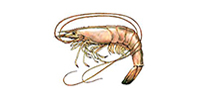Thank you for visiting the Seafood Selector. EDF is planning a new approach to providing information to consumers about good seafood choices. Please come back soon for updates.
Shrimp

Shrimp
Recommended servings per month
| Contaminant | Men | Women | Kids 6-12 | Kids 0-5 | |
|---|---|---|---|---|---|
| Shrimp and prawns (imported) | Mercury | 4+ | 4+ | 4+ | 4+ |
| Giant freshwater prawn (Asia) | Mercury | 4+ | 4+ | 4+ | 4+ |
| Giant freshwater prawn (U.S., Canada, Latin America) | Mercury | 4+ | 4+ | 4+ | 4+ |
| Pink shrimp (Gulf of Mexico and Mexico) | Mercury | 4+ | 4+ | 4+ | 4+ |
| Giant tiger prawn | Mercury | 4+ | 4+ | 4+ | 4+ |
| Spot prawn (Canada) | Mercury | 4+ | 4+ | 4+ | 4+ |
| Spot prawns (U.S.) | Mercury | 4+ | 4+ | 4+ | 4+ |
| U.S. farmed shrimp | Mercury | 4+ | 4+ | 4+ | 4+ |
| U.S. wild shrimp | Mercury | 4+ | 4+ | 4+ | 4+ |
| Blue shrimp | Mercury | 4+ | 4+ | 4+ | 4+ |
| Brown shrimp | Mercury | 4+ | 4+ | 4+ | 4+ |
| Chinese white shrimp | Mercury | 4+ | 4+ | 4+ | 4+ |
| Northern shrimp (U.S., Canada) | Mercury | 4+ | 4+ | 4+ | 4+ |
| Pink shrimp (Florida and Southern Atlantic) | Mercury | 4+ | 4+ | 4+ | 4+ |
| Pink shrimp (Oregon) | Mercury | 4+ | 4+ | 4+ | 4+ |
| White shrimp | Mercury | 4+ | 4+ | 4+ | 4+ |
| Whiteleg shrimp (Ecuador) | Mercury | 4+ | 4 | 4+ | 4+ |
Eco details:
- Although Best Choices, U.S. farmed shrimp, spot prawns from Canada and Oregon pink shrimp (bite-size ""cocktail"" shrimp) are a small fraction of the shrimp sold in the U.S. market.
- Why? Most shrimp (90 percent) eaten in the US. is imported from Southeast Asia and Latin America, where environmental regulations are often lax or not enforced.
- The rest on the market (10 percent) comes from the Southeast U.S. (Gulf of Mexico and Atlantic Ocean), where fisheries and farms are held to stricter environmental standards.
- OK Choices are northern shrimp and U.S. wild shrimp.




